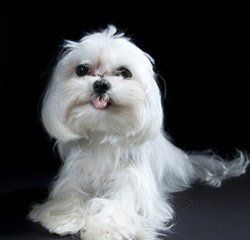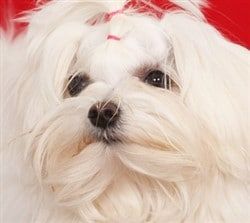Maltese Feeding Guidelines
Feeding Transitions for New Maltese Puppies
When you first bring your new Maltese puppy home, you may wish to feed him a different brand than what he is used to. And making a change is certainly encouraged if you will be transitioning to a better formula.
However, you will want this to be a gradual change. Making a fast switch can cause upset stomach issues, and a puppy may not be too keen for new flavors.
Most breeders will send a new pup home with a small amount of his food that usually covers a few days. So, you'll want to find out the exact brand and formula so that you can have a bag on hand that will last a couple of weeks.
You will also want to have a bag of your new chosen food that you wish for your Maltese puppy to be eating. The idea will be to do a gradual change-over.
- During the first week, mix both together; 1/4 new food to 3/4 old.
- For week two, mix 1/2 old to 1/2 new
- For week three, mix 3/4 new to 1/4 old
- By the beginning of week four, your Maltese will be be solely on the new food.
Which is Best for Maltese, Dry or Wet?
If given the choice, most dogs would take wet dog food over dry; however, this is not usually the best choice for them. A diet of only wet food may lead to runny bowels. In addition, the texture of dry kibble is better for the teeth.
Therefore, dry kibble is best for most Maltese, though you can mix in a bit of wet food (the same brand as what you are choosing for dry is recommended), or drizzle a bit of low-sodium chicken or beef broth over the kibble if your Maltese needs a small bit of encouragement.
If you do opt for wet dog food, or home cooking, do be sure to follow all at-home dental care tips, which includes a daily dental chew.
Also, warming food can help encourage meals to be eaten; this can be done in the microwave; however, be sure to stir the food once it is done warming, and check the temperature with your pinkie finger or inner wrist to ensure that it is not hot to the touch.
Grain vs Grain-free Foods
What to know:
For quite some time, a grain-free food was indisputably the right choice for many dogs since heavy grains were thought to be the trigger for intolerance or allergies. However, some concerns that were recently raised regarding grain-free dog food caused veterinarians, and owners, to take pause.
It's important to understand what is known at this time, what is merely speculation, and what requires many more years of studies.
In the US, four dogs (a Miniature Schnauzer, a Shih Tzu, and two Labrador Retrievers) that are not breeds prone to dilated cardiomyopathy (DCM) developed this serious heart disease. And, it was discovered that all four were also on a grain-free diet that had high levels of peas, lentils, other legume seeds, or potatoes. At this time, there have been 524 reported cases.
Dec 2018 update:
However, in time, new information was acquired and an update given by the Veterinary Medical Center at Tufts University showed that there is not necessarily a link just to grain-free kibble with those particular additional high-carb or high-fiber ingredients, but rather that there may actually be a link between DCM and 3 elements occurring at the same time: boutique food (small specialty brands), exotic meats (like kangaroo, bison, alligator, venison, and ostrich), and
a grain-free recipe with those peas, potatoes, and legumes as the top 5 ingredients. This sort of diet has been given a name: A BEG diet.
July 2019 update:
The FDA released a summary of the 524 cases of DCM along with information regarding which brands and recipes of dog food the dogs were eating. The top 16 brands were named, which are:
Acana (67 reports)
Zignature (64 reports)
Taste of the Wild (53 reports)
4Health (32 reports)
Earthborn Holistic (32 reports)
Blue Buffalo (31 reports)
Nature’s Domain (29 reports)
Fromm (24 reports)
Merrick (16 reports)
California Natural (15 reports)
Natural Balance (15 reports)
Orijen (12 reports)
Nature’s Variety (10 reports)
Nutrisource (10 reports)
Nutro (10 reports)
Rachael Ray Nutrish (10 reports)
Putting this in perspective:
Though those 524 cases should not be ignored and there may very well be more as new reports come in, this is a very small number given that there are an estimated 77 million dogs in the US. And, on the report of those cases,there were just 2 Maltese dogs; a 10-year-old male and a 12-year-old female.
What to do:
As of right now, there are no recalls connected to this. Many more studies need to be done and will be over the coming years. At this time, experts recommend that owners stop feeding their dogs a BEG diet, and this is particularly applicable to breeds prone to DCM. Note that the Maltese is not prone to DCM, but is prone to MVD (degenerative mitral valve disease) as are most other toy breed dogs.
So, this means that if a grain-free food is chosen, it should have traditional meats like chicken, turkey, lamb, beef, pork, or fish instead of exotic meats. If you wish to add in some grains, consider gluten-free or low gluten options (which can help bypass wheat allergies) such as rice (white or brown), oatmeal, and quinoa.
Recommendations for both grain and grain-free options are ahead under 'Recommended Dog Foods for Maltese Puppies and Dogs'.
Feeding Guidelines - How Often
Feeding a small toy breed like the Maltese is a bit different then with larger dogs.
New puppies - From the 8 week mark to the 12 week mark (the first month), it is recommended to free-feed. This is the method of leaving out fresh food at all times.
This is because very young pups can develop hypoglycemia (rapid drop in blood sugar levels) and one of the causes of this is not eating often enough.
You will want to remind your new puppy of where his food is located. Also, do not 'top off' the bowl. Keep small quantities in the bowl, and toss and replace as needed since stale kibble is seldom appealing to puppies.
Puppies
- From the age of 12 weeks to the 9 month mark Maltese puppies should be fed 3 meals per day. It is recommended to not maintain the free-feeding method because by this age most Maltese will eat more if they have scheduled meals.
If you will be gone for the mid-day meal, you can leave this in a bowl or place a serving inside a treat dispensing toy. Mixing your chosen kibble with a bit of smooth, all-natural peanut butter is usually a well-received method for filling treat-release chews.
Because Maltese are such a small breed, it is not always easy to find a properly sized treat-release toy; most are just too big. If you are looking for a good one, the PetSafe Busy Buddy Barnacle Toy, Extra Small
 is really great.
is really great.
Adults
- Small dogs need to eat more frequently than their larger counterparts, so most adult Maltese will never do well with just one meal a day. Adult Maltese can continue eating 3 small meals per day or transition to two.
Both options are appropriate and will depend on a particular Maltese's preferences, if a Maltese needs to be home alone
during the day, and how often snacks are given.
How Much to Feed a Maltese
Maltese puppies and dogs eat a surprisingly small amount of food; and if you have had larger breeds in the past it may be hard to believe that such tiny servings properly fuel this breed.
Before we dive into how much food a Maltese should eat, it must be pointed out that different foods vary quite a bit in regard to calories. And that is what this all comes down to.
Some foods, particularly higher quality dog foods and home cooked food, are calorie dense. Therefore, serving sizes are often smaller than with less-than-ideal brands.
In addition, cheaper, inferior foods may be packed with fillers which do not offer as much nutrition per serving, so a Maltese may need to eat more to receive the same amount of calories.
Calorie requirements: Growing puppies need about 55 calories per pound of body weight, per day. And dogs that have reached their adult size (about the 9 month mark for Maltese) need approximately 45 calories per pound of body weight, per day.
Note
that this number can go up or down 20%, and depends on a dog's activity level, health, age, and individual metabolism.
Serving sizes: Dog foods list recommended feeding guidelines on the packaging which are based on their particular formula, and both a dog's age and weight and these are pretty spot-on. Do, however, keep in mind that these servings sizes are usually per day (not meal) and it is assumed that you are offering several snacks per day.
This said, in general the guidelines are:
Maltese from 2 to 4 pounds
will eat about 1/4 cup to 1/2 cup per day.
Maltese 5+ pounds
will eat about 1/2 cup to 3/4 cups per day.
Choosing the Best Food for Maltese Puppies and Dogs
Don't need all these details and just want to skip to recommendations?
Jump down to 'Recommended Dog Foods for Maltese Puppies and Dogs'.
Fillers
- These are worthless ingredients that are added to some cheap dog foods to plump it up. This is done to make it appear as if there is more real food than there actually is.
Fillers have very few calories and typically are not absorbed by the body; they come right back out without offering any nutrition. Common dog food fillers include corn bran, corncobs, oat hulls, peanut hulls, cottonseed hulls, rice hulls, soybean mill run, wheat mill run, citrus pulp, and cereal by-products.
Artificial additives
- These can really do a number on a dog, and particularly a toy breed like the Maltese. Though a dog can be allergic to any food including certain proteins, most food allergies are due to additives.
The ingestion of chemical preservatives, coloring, and/or flavoring can cause a host of issues. Most common are upset stomach, nausea, and/or diarrhea, poor skin and coat health, and allergic reaction including rashes, itching, hot spots, and/or thinning coat.
Generic meat sources
- Be very careful with these. If the meat in the dog food is not named, it may legally
be any road kill, deceased zoo animals, poultry that dies while on route to facilities, diseased or dying livestock, and pets that have been euthanized at shelters.
By-products
- Animal by-products includes animal parts that are not fit for human consumption.
So, even if you see somewhat unassuming ingredients such as 'chicken by-product' keep in mind what this means.
This will include such things as feet,claws, beaks, backs, lungs, eyes, brains, spleen, kidneys, intestines, undeveloped eggs and essentially any part of an animals; nothing is off limits.
Dog food sourced and/or prepared overseas
- There is very little trust in food ingredients sourced or prepared in China, and for good reason. We will touch on this ahead.
Qualities of the best food for your Maltese puppy or dog:
Now that we've gone over what to avoid, let's take a look at what you'll want your Maltese's food to have:
Wholesome food ingredients without any fillers-
You'll want a quality blend that contains only real foods without any extras throw in.
Zero additives
- A brand that does not add any chemicals or artificial ingredients.
Real meat sources
- Chicken and turkey are usually great choices, as these are well tolerated. Also lamb, bison, fish blends, and rabbit are great as well.
Other healthy ingredients
- Fish oil (salmon, mackerel, etc.) are always a bonus to have in a kibble, as this is fantastic for good skin and coat health. Your chosen food should also have a good selection of fruits and vegetables for a balanced diet.
Proper size
- Being so tiny, most Maltese do best with kibble that is sized for small toy breeds. This will make it easier for the puppy or dog to eat, and the consistency will be appropriate for tiny mouths and teeth.
Made in North America (US and Canada)
- Be very careful with this. A 'Made in the USA' label may
simply mean that the dog food was mixed, blended, and packaged in the US; but, the meat could have been sourced from China.
Meats from China have been linked to 500+ deaths of pets (both cats and dogs), and over 3000 complaints of illness. You will want to choose a dog food that is both
sourced and packaged in North America (US or Canada).
Recommended Dog Foods for Maltese Puppies and Dogs
Please note:
If you have not yet read our updated information regarding grain vs grain-free foods, you may wish to do so before reading on.
With grains:
1. Wellness Complete For Small Breeds . Wellness is a top brand that puts lots of care into their recipes. This has a base of turkey and oatmeal (which is great for dogs that have sensitive tummies).
. Wellness is a top brand that puts lots of care into their recipes. This has a base of turkey and oatmeal (which is great for dogs that have sensitive tummies).
Other ingredients include salmon and flaxseed (both are good sources of omega-3 fatty acids), chicken, brown rice and barley (both of these grains are usually very well tolerated), carrots, spinach, sweet potatoes, blueberries, and apples. All other ingredients are either to natural preserve the food, naturally flavor it, or are vitamins and minerals.
This food is 100% all-natural with no wheat, corn, soy, meat by-products, artificial flavors, colors or preservatives, this is sized perfectly for most Maltese, and is made in the USA.
2. Halo Natural Chicken & Liver for Small Breeds . This is a holistic brand that focuses on non-GMO vegetables and fruits, and meats that are cage-free, hormone-free, antibiotic-free, and with no 'factory farming'. Meats are also whole, not meals (compressed). This formula has a base of chicken and chicken liver which offers a great burst of flavor that most canines find delicious.
. This is a holistic brand that focuses on non-GMO vegetables and fruits, and meats that are cage-free, hormone-free, antibiotic-free, and with no 'factory farming'. Meats are also whole, not meals (compressed). This formula has a base of chicken and chicken liver which offers a great burst of flavor that most canines find delicious.
Other ingredients include eggs, peas, oats, vegetable broth, pearled barley (usually a well-tolerated grain), salmon (an excellent source of omega-3), flaxseed, sweet potatoes, apples, blueberries, green beans, carrots, cranberries, and zucchini, so there is a lot of variety with plenty of fruits and veggies. All other ingredients are either to natural preserve the food, naturally flavor it, or are vitamins and minerals.
There is no artificial coloring, flavoring, or preservatives, and no by-products or soy. This is sized for small dogs and is made in the USA.
Grain-free:
1. Halo Grain-Free Game Bird Medley for Small Breeds . As mentioned above, Halo is a holistic all-natural brand with an emphasis on non GMO produce and meats that are cage-free, hormone-free, and antibiotic-free. Fruits and vegetables are sourced from local farms.
. As mentioned above, Halo is a holistic all-natural brand with an emphasis on non GMO produce and meats that are cage-free, hormone-free, and antibiotic-free. Fruits and vegetables are sourced from local farms.
This particular grain-free recipe has a base of turkey, duck, and goose which offers lots of flavor. Other ingredients include chickpeas, egg, lentils, blueberries, cranberries (both good sources of antioxidants), sweet potato, flaxseed, and carrots. All other ingredients are either to natural preserve the food, naturally flavor it, or are vitamins and minerals.
There is no soy, no by-products, no artificial additives, and no chemical preservatives. This is made in the USA, and the size of the kibble is ideal for most Maltese.
2.Wellness CORE Natural Dry Grain-Free for Small Breed Dogs
 is top-quality kibble that is very calorie dense, and every ingredient serves an important purpose.
is top-quality kibble that is very calorie dense, and every ingredient serves an important purpose.
The main protein is turkey and chicken, which is well tolerated by most dogs. There are also peas, potatoes, spinach, broccoli, carrots, apple, blueberry, kale, and sweet potatoes. It is fortified with antioxidents, probiotics, vitamins and minerals. There are good amounts of omega 3's with both salmon oil and flaxseed.
This dog food also contains both glucosamine and chondroitin (important for joint and bone health) and has no grain, corn, soy or wheat. There are no artificial additives, no synthetic preservatives, and no by-products. This is both sourced and made in the USA.
3. Merrick Lil' Plates Grain-Free for Small Breeds . This is another great choice is you wish to go with a grain-free diet with four recipe bases that all have traditional meats: lamb, beef, chicken, or salmon. Each of these is paired with sweet potatoes.
. This is another great choice is you wish to go with a grain-free diet with four recipe bases that all have traditional meats: lamb, beef, chicken, or salmon. Each of these is paired with sweet potatoes.
In looking at the lamb recipe, other ingredients include peas, chickpeas, whitefish, apples, and blueberries. All other ingredients are either to natural preserve the food, naturally flavor it, or are vitamins and minerals, including probiotics and prebiotics. This also has no artificial additives or by-products, is sized for small dogs, and is made in the USA.
Related:
Choosing the Best Snacks for Maltese
- Be very careful with what you offer for treats; there are some terrible ones out there, but also some truly fantastic choices for an extra boost of nutrition and yummy rewards.
Home Cooking for a Maltese
- This can be a great option to offer healthy, additive-free meals and can work well for fussy eaters.
Supplements for Maltese
- Not all dogs need supplements, but certain ones can be very helpful, and all Maltese age 6 years and up should be given a joint supplement. Read the what can help with a wide variety of issues.
When a Maltese is a Picky Eater
- If your Maltese is super finicky, these 7 steps will help turn this behavior around with the least possible stress.

Bathing will either be detrimental or beneficial to the skin and coat

The top 7 care tips for optimum health, comfort & happiness
Keeping the eye area a snowy white without any discoloration
Spotlight Article
Some Maltese can be very vocal; fortunately, there are some techniques that can nip this in the bud.

-min-450x169-1920w.jpg)

